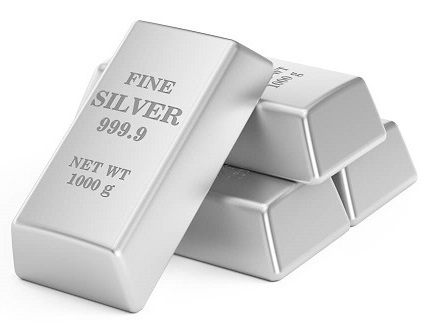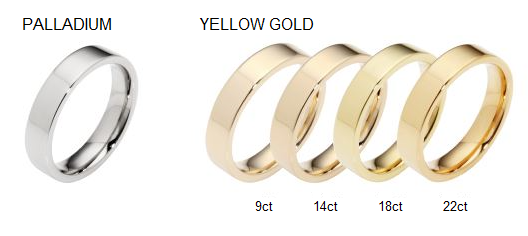Silver is one of the first metals to be used by humans. It is also the most reflective of all the metals and can be polished to a higher sheen than platinum. In fact, the chemical symbol for silver, Ag, is derived from the Latin word argentum, meaning 'white and shining.' It is extremely malleable and resists oxidation from exposure to the atmosphere. Silver also has the highest thermal and electric conductivity of any substance. Silver is widely distributed in nature, but the total amount is quite small when compared with other metals. Unlike gold, silver is present in many naturally occurring minerals.

Silver metal in jewellery.
Silver ornaments and decorations have been found in royal tombs dating back as far as 4000 BC, and silver has been used, along with gold, as money for centuries. Today, over 90% of the silver mined is not used for jewellery, but in industrial applications. Compounds of silver are used to make mirrors, electrical contacts, dental fillings, coins and electroplating. Over 40% of all silver mined in the United States is used as silver nitrate and silver halide in photographic developing.
Silver can be polished, matte, brushed, satin, sandblasted, oxidized (blackened using chemicals) or antiqued. Silver is often said to have a patina, or worn appearance that is achieved through frequent use and handling. In its pure form silver is almost as soft as gold, and is therefore usually alloyed with copper. Alloys of silver with copper are harder, tougher, and more fusible than pure silver and therefore, are used for jewellery. The proportion of silver in these alloys is stated in terms of fineness, which means parts of silver per thousand of the alloy.
The use of silver dates back many years, demonstrating the metal's rich history. In ancient Egyptian times, some believed that silver possessed religious and spiritual significance, and it was often used during worship. Originally considered much more precious than gold, silver did not become available to the middle class until the 16th and 17th centuries. In the 1800s, nobility began using silver in their tableware, flatware, and other serving accessories.
Since early history, "silver" went by many different names. First introduced in 12th-century lore, "sterling" became part of silver's common name. As payment for English cattle, an association of eastern Germans compensated the British with silver coins dubbed "Easterlings." Eventually, the Easterling was widely accepted as a standard of English currency. Ultimately abbreviated to "Sterling," the name now refers to the highest grade of silver metal.
As mentioned, due to its high level of inherent softness, pure silver is actually too malleable to be used alone in jewellery making and it is easily dented or scratched when exposed to daily wear and tear. Instead, silver is typically mixed with other alloy metals to give it strength. Copper is the most commonly chosen companion; its durable resilience lends stability and longevity to sterling silver pieces.
Sterling silver contains 92.5 percent silver and 7.5 percent other metals, usually copper, so its fineness is designated "925". It also may say "Sterling" on the back of the piece. This is the standard that determines whether a jewellery piece can be designated as "sterling" or pure silver, anything less than 92.5% does not qualify. There are lesser grades of silver.
If your jewellery becomes tarnished over time, use a soft silver polishing cloth or silver polish cream to gently clean the silver parts, see 'Care & Maintenance' below. Do not use abrasive cloths or cleansers, or immerse your pieces in tarnish-removal solutions.
Pure silver possesses a milky-white or grey color. Most reputable jewellers, coat all their silver jewellery pieces with a layer of rhodium metal to create a lustrous, long-lasting shine comparable to white gold. The rhodium coating can be reapplied periodically to return the piece to its original, bright gleam.
The most reliable method of ascertaining the purity of a sterling silver piece is to examine it for hallmarks. First implemented in France and Great Britain as early as the 14th century, a hallmark is a stamp or marker applied to a piece of silver jewellery to indicate the amount of its pure silver content, and in some cases also signifies the date of production and country of origin. These stamps are usually applied with a special branding tool or small hammer. A stamping of ".925," "Sterling," or "coin" all indicate that a silver jewellery piece meets the "sterling" or pure silver standard. Although it is not a government-mandated law in the United States to stamp a piece of jewellery with its hallmark.
Silver is more prone to tarnishing from oxidization than other precious metals, which can cause its surface to dull or turn black. You can help prevent these undesirable effects and extend the longevity and beauty of your silver pieces, by following the proper guidelines for care, cleaning, and storage. Since it's much softer than other metals and gemstones, silver requires special cleaning methods to retain the integrity of its texture and composition.
To remove oil, dirt, tarnish, and smudges from the surface of silver, you should polish it regularly with a soft cloth. Never use rough or coarse fabrics, as these can result in scratching. Avoid using harsh chemical cleaners, especially those containing bleach, which can discolor silver. Every few months, you might consider taking your silver piece to a professional jeweller for a thorough cleaning, and after several years of constant wearing, perhaps a fresh coating of rhodium to recapture its original shine. At some reputable jewellers, each of their fine silver jewellery pieces comes with complimentary professional cleaning and polishing services for life to restore your purchase to its original luster. Perhaps even more important than a proper cleaning regimen is the method of storage used for your silver pieces. To prevent the oxidization that can cause dullness and tarnishing, each silver piece should be stored in its own soft pouch, plastic bag, or box lined with tarnish-resistant material. Avoid keeping silver in warm, moist environments, like bathrooms. Instead, store jewellery in a dry, cool location.
More pure than traditional sterling silver, Argentium silver modifies the traditional alloy by replacing some of the copper with germanium making this a nickel-free metal. The two available grades of Argentium, .932 and .960, each contain more pure silver than sterling, giving this alloy its bright, white color. The nature of this metal ensures the natural color stays consistent throughout the lifetime of the piece, making rhodium plating unnecessary. Argentium comes from recycled silver and guarantees the traceability of its raw silver.
Argentium silver is the whitest metal available, outshining white gold, sterling silver, palladium, and platinum. During the quality-assurance laboratory testing, scientists discovered that argentium was far more tarnish-resistant than traditional sterling silver. When forced to contend with the harsh effects of pollution, perspiration, and ultraviolet light, Argentium passed the tests 100% of the time. Argentium is highly sought after due to its sustainability, easy maintenance, and superior brightness and shine.
If you're considering buying 925 Sterling silver and you are new to the jewellery industry, you will no doubt want to know the difference between pure silver and 925 sterling silver. Sterling silver is a popular metal used to make jewellery and other decorative items.
As mentioned, pure silver is not really made up of only silver. It has 99.9% of silver, and a small content composed of other metals such as copper. Sterling Silver, on the other hand, consists of 92.5% silver, and the remaining part consists of copper, mostly copper. This is the reason why sterling silver is popularly referred to as 925 Sterling Silver or just 925 Silver.
The reason silver needs to be combined with other metals is that it is very difficult to make great designs with just pure silver, which is very soft and malleable. A bit of hardness has to be introduced, by adding other metals such as copper. That's why jewellers are capable of making the most intricate and complex designs with 925 Sterling Silver.
Fine silver is the closest to the pure element, as it contains 99.9% silver. It's soft and malleable, and it easily gets scratches and dents. It may not be best for rings and bracelets, but fine silver is best for necklaces and earrings.
Silver is far less expensive than other precious metals like gold and platinum. The main factor considered when pricing a piece of silver jewellery is the metal's current market price per gram. As a general rule, the heavier a piece of sterling silver, the higher the price. The base price is a calculation of the item's weight and the current cost per gram, although that's not the only contributing factor. Other considerations include labor costs to forge and finish the piece, added materials such as rhodium and gemstones, and the level of intricacy and craftsmanship required to complete the piece.



Precious metals comparison.